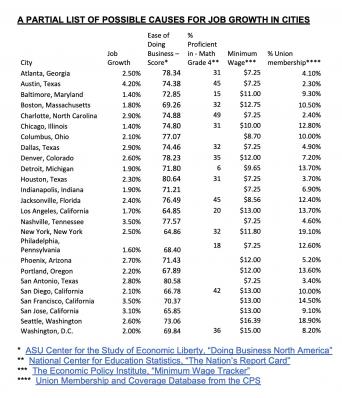
Can Changes in Policy Increase Job Growth In Philadelphia?
Although cooperatives have the potential to change the ways that commodities are produced and distributed, they are still dependent upon the same governmental policies under which more traditional businesses operate. Currently, Philadelphia is the nation’s poorest large city, with a poverty rate hovering around 23%, according to an October 2020 column in the Inquirer. So can the municipal government institute policies to help accelerate job development?
The Inquirer recently launched a series of articles under the title “The Future of Work,” which identified a number of possible reasons for the city’s anemic 1.6% annual job growth rate in the private sector, which leaves it in 23rd place out of the 25 municipalities examined. Among the potential causes listed were inadequate educational achievement, the low minimum wage, high union membership rates and the difficulties of doing business here.
But what assurances do taxpayers have that government investment in these areas will be successful in generating new employment opportunities? For example, if we accept the ease of doing business as a basis for new jobs, how do we interpret the success of a city like San Jose, CA, which ranked fourth out of 25 cities for job growth, but ranked lower (79) than Philadelphia (71) on the ease of doing business?
More rigorous statistical methods might help civic leaders determine where investment would be most appropriate. In performing a modest analysis, I examined how job growth correlated with educational achievement (for example, the percentage of students who were proficient in reading and math for grades 4 and 8); the minimum wage, union membership rates, and the ease of doing business. This last category included such components as what’s involved in starting a business, hiring workers, getting electricity, securing land and space, and paying taxes.
The only candidates that came close to meeting the standards of statistical significance were the ones involving educational achievement, with fourth grade math percentages being particularly impressive.
Apprenticeship programs such as PowerCorpsPHL, which boasts an employment placement rate of 90%, appear to substantiate the importance of education to employment in the city. If future exploration suggests educational achievement as an important predictor of new jobs, Philadelphia’s public schools may be a good target for additional investment.
According to the School District of Philadelphia’s website, in 2019 only 22% of the district’s students were proficient or more than proficient on Pennsylvania System School Assessment tests in math; 36% met this standard in English language arts. When it came to proficiency on the Keystone Algebra I and Literature exams, 20% and 41%, performed at least proficiently.
This analysis raises a number of concerns:
- Union membership is a debatable factor, because these numbers are based upon metropolitan areas rather than areas strictly within a city’s boundaries. Since cities are often centers of employment for many suburban union members, there may be justification for using these numbers. But there should be consensus on the matter.
- Is there no connection, or are there multiple connections between minimum wage and job growth? Whereas minimum wage is a burden to some companies seeking to lower their operating costs, other companies might welcome the better educated and trained labor force that minimum wage laws may attract.
- The connection between fourth grade math proficiency and employment seems like a stretch, but a clearer picture might emerge if we were to increase our sample size and examine 12th grade proficiency data, once it is available.
- There are no doubt other critiques with this analysis, but such criticisms should be used to hone its method, not avoid it. This proposal is simply a starting point. More robust evaluations of possible predictors of job growth will hopefully develop along with the rising interest in how to fortify Philadelphia’s economy. We need the city to recover not only from the impact of COVID-19, but also from the effects of automation and outside competition.

